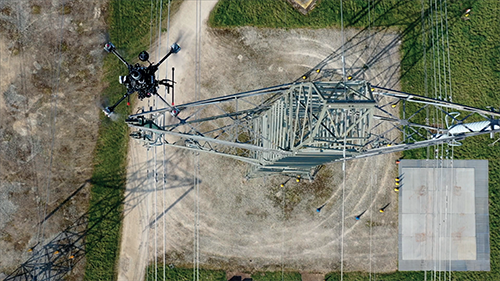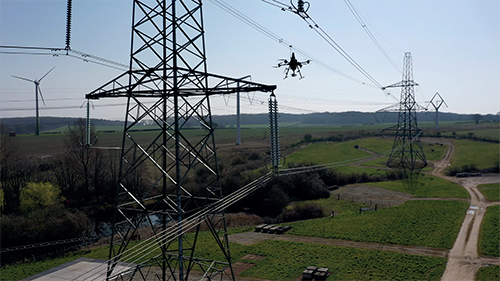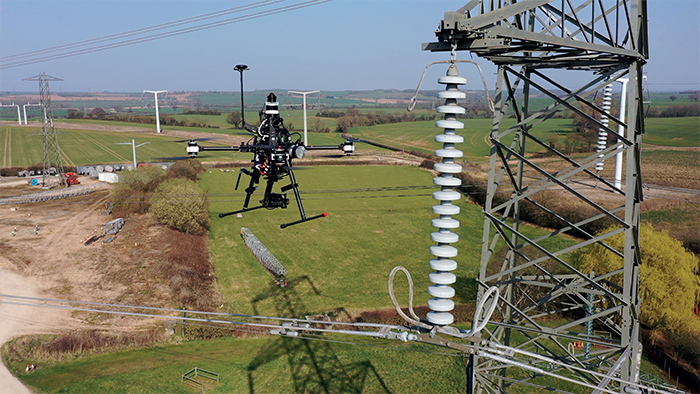Using autonomous drones to inspect pylons By Kathryn Fairhurst
BLUE SKY THINKING
Building a net zero power system fit for the demands of tomorrow means innovating today – and at National Grid Electricity Transmission (NGET) we know that innovation and collaboration are the best way to tackle some of the biggest challenges in energy.
As the body responsible for building and maintaining the infrastructure to transmit clean electricity to homes and businesses across the country, we have a key role to play in Britain’s decarbonization journey. But it’s a journey we’re on together with industry.
Over the last year we’ve teamed up with 19 partner organizations on over a dozen NGET-led innovation projects funded by Ofgem’s Network Innovation Allowance (NIA) and its new Strategic Innovation Fund (SIF).
One project is particularly eye-catching, and sees us working with deep tech start-ups Keen AI and sees.ai to boost our field operations by harnessing the latest in artificial intelligence and autonomous flight technology.
We’ve launched trials of a system which, using computer-manned drones, aims to fully automate the capture and processing of data that tells us what condition our pylons and overhead lines are in.
This is a job our field ops teams have traditionally carried out on foot or by helicopter, which is an enormous task. We own 21,900 steel lattice pylons that carry overhead transmission conductor wires across England and Wales, each of which needs a routine close-quarter health assessment to monitor for corrosion which can affect them over time.
There’s only a certain number of pylons our field teams can assess in a year – normally around 3650 – owing to limitations with our current methods.
For example, our expertly trained engineers can ascend the pylons to inspect them. That’s much safer today with modern climbing equipment and precautions we have in place, but it’s slow and not without risk. Our helicopters can help us cover a wider area, but do not allow us to inspect the pylons up close – not to mention being less carbon-efficient.
More recently we’ve used manually-flown drones. This has significantly enhanced our capability – allowing closer inspections without associated risk – but these drones are still resource-intensive, needing a team of pilots and spotters to keep them in sight at all times to ensure safe operation.
Autonomous drones could be a game-changer, and it’s why we’re so excited about this innovation project. Working with Keen AI and sees.ai, we’re bringing together the brightest minds and best ideas to find a new solution to a challenge we’ve always had to tackle.
The efficiency savings are already clear in our trials. In about the time it would take for our engineers to kit up with climbing gear, one of the autonomous drones we’re trialing could take off, gather detailed close-quarter data and imagery, send them wirelessly for processing, and then land itself.
Currently, images from our helicopter and manned-drone flights are processed manually by a pool of inspectors. With the help of sees.ai’s autonomous drone inspection system, in our trial the data and imagery are automatically transmitted to an AI system – courtesy of Keen AI’s technology – which assess corrosion, proposes maintenance work, and can even predict the future state of a pylon.
It’s not only enabling the capture of data that’s optimal for automated processing; it’s also increasing the speed, efficiency and consistency of data processing.

The trial brings another advantage over manned drones. While the latter needs carrying to the site of the pylons being inspected – and then kept in sight while being flown – our project will enable a fleet of connected and autonomous drones to be flown nationally under license from the Civil Aviation Authority and under the supervision of operators in a secure remote operation center.
This ‘Beyond Visual Line of Sight’ (BVLOS) drone capability could transform how we monitor the network in the future. It’s more likely to complement, rather than replace, the methods we currently use in the foreseeable future, but – given the spread of our infrastructure across the country – it brings obvious benefits in terms of efficiency, safety and environmental impact.
Autonomous flight isn’t the only way we’re innovating to help Britain decarbonize. We have a portfolio of exciting projects underway that are helping us deliver the biggest transformation of the electricity transmission network since it was built.
That includes an initiative to upgrade Britain’s lower voltage overhead lines to a higher capacity, boosting existing network capacity without the need to build new infrastructure – meaning lower costs for consumers and more renewable generation able to connect to the grid faster.
We’re also working with the European Space Agency to harness satellite data to improve grid resilience, enhancing the emergency response capability of Britain’s networks to extreme weather events.
Collaboration is the key ingredient in all of these projects: now more than ever is the time for the energy industry to work together to innovate for net zero.
Kathryn Fairhurst
www.nationalgrid.com
Kathryn Fairhurst, is Head of Engineering Services, National Grid Electricity Transmission. National Grid Electricity Transmission (ET) owns and maintains the high-voltage electricity transmission network in England and Wales. The company transports electricity through over 5000 miles of power lines and 300 substations enroute to Britain’s homes and businesses, and invests £1.3 billion in the network each year to connect more renewables to help achieve net zero.
